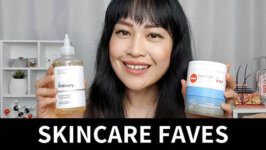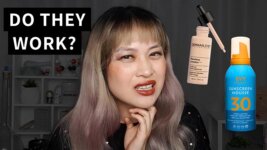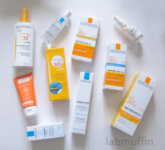I’ve talked about visible light and blue light, and their effects on pigmentation in lots of detail before. There’s been more studies done since then – fortunately my conclusions are still correct!
In short, the vast majority of us don’t have to worry about visible light or blue light coming from our screens. There just isn’t enough light coming from them. But if your skin is darker and more prone to pigmentation, you might have to worry about visible light coming from the sun. Visible light from the sun (in particular, short wavelength, high energy blue light, also called high energy visible (HEV) light) can worsen pigment problems like melasma and post-inflammatory hyperpigmentation.
Related post: Will Blue Light from Computers and Phones Damage Your Skin?
So this post will be an update on how to protect your skin against blue light – and you might be doing it already!
Here’s the video – keep scrolling for the written version.
How does blue light cause pigmentation?
This topic is still not very well researched, but it seems like it’s mostly to do with a photoreceptor (a protein in your skin that senses light) called opsin-3. Once opsin-3 is triggered by enough blue light, it sends a signal to the pigment-producing melanocytes in your skin to produce more pigment. It might also have something to do with oxidation and free radicals, but this seems to be less important.
Some studies have found that some antioxidants may be able to reduce pigment production after blue light exposure, but the focus is mostly on preventing that blue light from getting to your skin in the first place. Basically, it’s about making products that work like sunscreen, but for blue light.
Which products protect against visible light?
So which products will actually protect your skin against blue light?
Earlier research found that regular sunscreens actually aren’t that good at protecting against visible light. Even if you have a thick white layer of zinc oxide or titanium dioxide sunscreen, it still doesn’t work very well.
But some of the earlier studies found that tinted physical sunscreens gave pretty good protection. Physical or mineral sunscreens are the ones that contain zinc oxide and or titanium dioxide, while the tint is from iron oxides.
There are three iron oxides that are used to make products look skin-coloured, and they’re found in products like foundations and tinted sunscreens. They’re often listed as their colour index (CI) numbers:
- Red iron oxide: CI 77491
- Yellow iron oxide: CI 77492
- Black iron oxide: CI 77499
They’re added in different amounts and different ratios to get the different shades of skin.
All three iron oxides absorb a bit of blue light, which is how they protect against it – hence the focus on tinted physical sunscreens.
Why physical sunscreens?
At this point you might be a little bit confused, because if you’ve watched my videos before, you’ll know that physical and chemical sunscreens mostly work the same way. Both mostly absorb UV and turn it into a small amount of heat; a few ingredients (most commonly zinc oxide, titanium dioxide and Tinosorb M) also scatter and reflect a tiny bit – but that amount is really tiny.\
Related post: Chemical vs Physical Sunscreens: The Science (with video)
So why is everyone focusing on mineral and physical sunscreens?
Here’s where it gets a little bit complicated: it’s to do with titanium dioxide.
Titanium dioxide is one of the active ingredients in mineral sunscreens. It’s good at protecting against UV, but it also tends to be the ingredient that gives the worst white cast.
One way of getting rid of this white cast is by chopping up the titanium dioxide into smaller micronised or nanosized particles. This makes the titanium dioxide scatter and reflect a lot less visible light, so you get less of that white look. It also increases UV absorption, making it work better as a sunscreen filter. But on the flip side, it tends to make it worse at visible light protection.
But when you have larger particles of titanium dioxide – 200-300 nanometers – you get really bad white cast, since they scatter and reflect so much white light. These larger particles are also worse at UV protection, so they’re not really used in sunscreens (although sometimes they form by accident, since smaller particles of uncoated titanium dioxide tends to clump together to form these larger particles, which is a problem – it brings down SPF and gives unnecessary white cast).
But this scattering of visible light that’s so annoying in sunscreens is actually pretty useful for visible light protection. Scattering means that the path of the light gets changed. Instead of taking a straight line through the sunscreen film, it’ll bounce around in the film for a bit longer, takin a longer path. And if you have iron oxides in there as well, there’s a higher chance of the light hitting some iron oxide and getting absorbed before it gets to your skin.

These larger particles are called pigmentary titanium dioxide, and as you expect from the name, they’re used as pigments rather than sunscreens. Pigmentary titanium dioxide is the main colour ingredient in white products like white eyeshadow and white eyeliner, but it’s in lots of other makeup products as well. White is really good at covering other colours up, adding opacity – like how you’d usually paint a dark object white before applying a pastel paint, a white pigment added to a coloured cosmetic makes it better at covering what’s underneath. Pigmentary titanium dioxide is used in foundations and tinted sunscreens to give them coverage – in fact, you usually find more titanium dioxide in these products than you find iron oxides.
So if you see a tinted sunscreen and it contains titanium dioxide, it doesn’t necessarily mean that it’s a physical sunscreen. If it has these larger particles of pigmentary titanium dioxide in it (which is the case with most tinted products), the titanium dioxide isn’t helping with the UV protecting, “sunscreen” role of the product, but rather the “tinted” part.
That means the “sunscreen” part isn’t actually that important in visible light protection – it’s the pigmentary titanium dioxide and iron oxides doing the heavy lifting. (Although sunscreen is still super important for protecting skin against UV though, which is more strongly linked to pigment and other changes in your skin than visible light is.)
What about chemical sunscreens?
Based on that, we’d expect tinted chemical sunscreens to protect against visible light as well – and yes, they do!
In a study from Brazil, the researchers looked at 41 different tinted sunscreens on the market. They measured how much blue-violet light went through a 2 mg/cm2 layer (the same standard thickness used for SPF measurements). They found that 26 of these sunscreens (almost two-thirds of them) blocked over 99.9% of the visible light. This included both chemical and physical sunscreens.
In the same study, they also tested three non-tinted sunscreens, and they found that they didn’t protect against visible light much at all.
What about non-sunscreen products?
Based on this mechanism, foundations also protect against visible light. In a couple of studies, it was actually foundation-like products with high coverage that gave better visible light protection than tinted sunscreens. This isn’t too surprising, since a more opaque product will have more pigmentary titanium dioxide and iron oxides.
- In one study, a foundation with SPF 35 gave better visible light protection than a tinted sunscreen with higher SPF.
- In another study, visible light protection wasn’t correlated with SPF (a higher SPF product isn’t necessary to protect from visible light).
Then why are so many of these visible light studies on tinted sunscreens, rather than on foundations?
I think it’s because a tinted sunscreen is way more practical for most people, who aren’t skin care and makeup enthusiasts.
A lot of people who are into skincare and makeup prefer using two separate specialised products – it means you have a lot more control over the final look. Tinted sunscreens only come in a few shades, so if your skin doesn’t match one of these popular colours, according to… someone in product development, then you’re not going to have a good colour match. It’s a lot easier to get the right shade if you use foundations, which tend to come in more colours.
There’s also the fact that SPF studies test the product at 2 milligrams per square centimetre. This is a pretty unrealistic amount for most tinted products – it can make you look like you’ve got face paint on! So if you’re only relying on a tinted sunscreen, and that tinted sunscreen has too much tint to apply the proper amount, then you’re going to have less UVA, UVB and visible light protection. But if you have a separate sunscreen as well – something that you can apply a lot of – then at least you’re not missing out on that UV protection.
But you can imagine how hard it would be for a dermatologist to convince someone who isn’t using either sunscreen or makeup to suddenly start using both. It’s much easier to convince them to start using a single product – and this is the direction that most companies seem to be heading in.
Hopefully the extra focus on tinted sunscreens means that they’ll start making more shades. And the fact that visible light affects people with darker skin more hopefully means that they’ll put more effort into making darker shades that actually match darker skin. This isn’t really something the beauty industry has been really good at so far, so I’m not sure how optimistic I should be…
In short, if you want to prevent pigment from the sun, your best bet is high UVA protection and a tinted product with heavy coverage. That can be a sunscreen and a separate concealer or foundation, or a tinted sunscreen that goes on well.
And like with UV, there are other ways to avoid visible light exposure aside from sunscreens – and if you combine these with sunscreens, it tends to work better. This includes staying in the shade during the middle of the day when it’s the sunniest, and using things like hats and clothing to protect your skin.
Related post: How to Choose UV Protective Clothing
References
Passeron T, The key question of irradiance when it comes to the effects of visible light in the skin (open access), J Dermatol Sci 2019, 93, 69-70. DOI: 10.1016/j.jdermsci.2018.11.011
Duteil L et al., Short-term exposure to blue light emitted by electronic devices does not worsen melasma, J Am Acad Dermatol 2020, 83, 913-914. DOI: 10.1016/j.jaad.2019.12.047
Regazzetti C et al. Melanocytes sense blue light and regulate pigmentation through opsin-3 (open access), J Invest Dermatol 2018, 138, 171-178. DOI: 10.1016/j.jid.2017.07.833
Peres G, Miot HA, Transmittance of UVB, UVA, and visible light (blue-violet) among the main Brazilian commercial opaque sunscreens (open access), An Bras Dermatol 2020, 95, 108-111. DOI: 10.1016/j.abd.2019.01.004
Duteil L et al., A method to assess the protective efficacy of sunscreens against visible light-induced pigmentation, Photodermatol Photoimmunol Photomed 2017, 33, 260-266. DOI: 10.1111/phpp.12325
Schalka S et al., A novel method for evaluating sun visible light protection factor and pigmentation protection factor of sunscreens (open access), Clin Cosmet Investig Dermatol 2019, 12, 605-616. DOI: 10.2147/CCID.S207256






One more reason to wear foundation, at least a little bit. Thank you for the update.
Why just not use blue filter from phone itself against it? Would that not be a good solution? 🤔
Phones aren’t a significant source of blue light, there’s no blue filter for the sun 😉
Would a tinted sunscreen with 12 percent zinc oxide provide good UVA protection? I use a chemical spf daily but I have a lot of PIH. I’m wondering if switching to a physical spf with a tint would help these dark marks
In general, zinc oxide doesn’t give very good UVA protection. The highest UVAPF I’ve seen is Neutrogena’s one which has around UVAPF 30 with 21% zinc oxide…
Hi Michelle!
I’m so happy that I found your blog and YouTube channel, I have learnt so much because I have a sensitive skin.
Can I know your opinion about the uriage age protect cream? They say it has protects agains Blue light but also has retinol, vitamin C and E.
Thank you once again!
Does this mean that LED light therapies could potentially make pigmentation worse? Especially the blue light therapies targeted for acne?